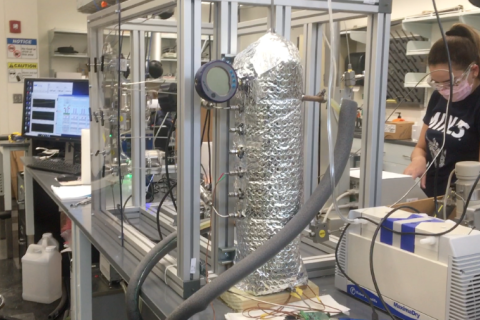U.S. natural gas futures jumped about 5% to a 10-week high on Aug. 16 on record global gas prices, a drop in daily U.S. output, a heat wave in California and forecasts for more hot weather and higher air conditioning demand in late August than previously expected.
That U.S. price increase came despite the ongoing outage at the Freeport LNG export plant in Texas, which has left more gas in the United States for utilities to inject into stockpiles for next winter.
Freeport LNG, the second-biggest U.S. LNG export plant, was consuming about 2 Bcf/d of gas before it was shut on June 8. Freeport expects the plant to return to at least partial service in early October.
Front-month gas futures rose 41.9 cents, or 4.8%, to $9.147/MMBtu by 8:33 a.m. EDT, putting the contract on track for its highest close since settling at $9.293 on June 7. On June 6, the contract closed at a near 14-year high of $9.322.
In the spot market, power and gas prices for Aug. 16 in southern California and Arizona jumped to their highest since September 2021 as homes and businesses cranked up their air conditioners to escape a heat wave.
To ensure the grid has enough resources to meet rising air conditioning demand, California's power grid operator told electric companies to delay unnecessary maintenance on their generating plants and power lines during the hot weather.
So far this year, the gas front-month is up about 144% as higher prices in Europe and Asia keep demand for U.S. LNG exports strong. Global gas prices have soared this year following supply disruptions linked to Russia's invasion of Ukraine on Feb. 24.
Gas was trading at record highs of around $71/MMBtu in Europe and $56/MMBtu in Asia.
The United States became the world's top LNG exporter during the first half of 2022. But no matter how high global gas prices rise, the United States cannot export more LNG because the country's plants are already operating at full capacity.
Russian gas exports via the three main lines into Germany – Nord Stream 1 (Russia-Germany), Yamal (Russia-Belarus-Poland-Germany) and the Russia-Ukraine-Slovakia-Czech Republic-Germany route – averaged 2.5 Bcf/d so far in August, down from 2.8 Bcf/d in July and 10.4 Bcf/d in August 2021.
Top producer
U.S. gas futures lag far behind global prices because the United States is the world's top producer with all the fuel it needs for domestic use, while capacity constraints and the Freeport outage prevent the country from exporting more LNG.
Data provider Refinitiv said average gas output in the U.S. Lower 48 states rose to 97.4 Bcf/d so far in August from a record 96.7 Bcf/d in July.
On a daily basis, however, output was on track to drop from a record 98.3 bcfd on Aug. 8 to a preliminary 15-week low of 94.3 Bcf/d on Aug. 16. Preliminary data is often revised later in the day.
With warmer weather expected, Refinitiv projected average U.S. gas demand, including exports, would rise from 95.3 Bcf/d this week to 97.5 Bcf/d next week. The forecast for this week was lower than Refinitiv's outlook on Aug. 15, but its forecast for next week was higher.
The average amount of gas flowing to U.S. LNG export plants has held at 10.9 Bcf/d so far in August, the same as July. That compares with a monthly record of 12.9 Bcf/d in March. The seven big U.S. export plants can turn about 13.8 Bcf/d of gas into LNG.
Recommended Reading
PGS Wins 3D Contract Offshore South Atlantic Margin
2024-04-08 - PGS said a Ramform Titan-class vessel is scheduled to commence mobilization in June.
Going with the Flow: Universities, Operators Team on Flow Assurance Research
2024-03-05 - From Icy Waterfloods to Gas Lift Slugs, operators and researchers at Texas Tech University and the Colorado School of Mines are finding ways to optimize flow assurance, reduce costs and improve wells.
Sapura Acquires Exail Rovins’ Nano Inertial Navigation System
2024-02-01 - Exail Rovins’ Nano Inertial Navigation System is designed to enhance Sapura’s subsea installment capabilities.
TGS Commences Multiclient 3D Seismic Project Offshore Malaysia
2024-04-03 - TGS said the Ramform Sovereign survey vessel was dispatched to the Penyu Basin in March.
Subsea Tieback Round-Up, 2026 and Beyond
2024-02-13 - The second in a two-part series, this report on subsea tiebacks looks at some of the projects around the world scheduled to come online in 2026 or later.





